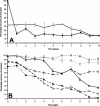Isolation and characterization of Campylobacter bacteriophages from retail poultry
- PMID: 12902236
- PMCID: PMC169066
- DOI: 10.1128/AEM.69.8.4511-4518.2003
Isolation and characterization of Campylobacter bacteriophages from retail poultry
Abstract
The ability of phages to survive processing is an important aspect of their potential use in the biocontrol of Campylobacter in poultry production. To this end, we have developed a procedure to recover Campylobacter bacteriophages from chilled and frozen retail poultry and have validated the sensitivity of the method by using a characterized Campylobacter phage (i.e., NCTC 12674). By using this method, we have shown that Campylobacter phages can survive on retail chicken under commercial storage conditions. Retail chicken portions purchased in the United Kingdom were screened for the presence of endogenous Campylobacter phages. Thirty-four Campylobacter bacteriophages were isolated from 300 chilled retail chicken portions, but none could be recovered from 150 frozen chicken portions. The phage isolates were characterized according to their lytic profiles, morphology, and genome size. The free-range products were significantly more likely to harbor phages (P < 0.001 by single-factor analysis of variance) than were standard or economy products. This study demonstrates that Campylobacter bacteriophages, along with their hosts, can survive commercial poultry processing procedures and that the phages exhibited a wide range of recovery rates from chicken skin stored at 4 degrees C.
Figures



References
-
- Ackermann, H., and M. S. DuBow. 1987. General properties of tailed phages, p. 28. Viruses of prokaryotes, vol. 2. CRC Press, Boca Raton, Fla.
-
- Adams, M. R., and M. O. Moss. 1995. Food microbiology. Royal Society of Chemistry, Cambridge, United Kingdom.
-
- Cogan, T. A., S. F. Bloomfield, and T. J. Humphrey. 1999. The effectiveness of hygiene procedures for prevention of cross-contamination from chicken carcases in the domestic kitchen. Lett. Appl. Microbiol. 29:354-358. - PubMed
Publication types
MeSH terms
LinkOut - more resources
Full Text Sources
Other Literature Sources
Molecular Biology Databases

